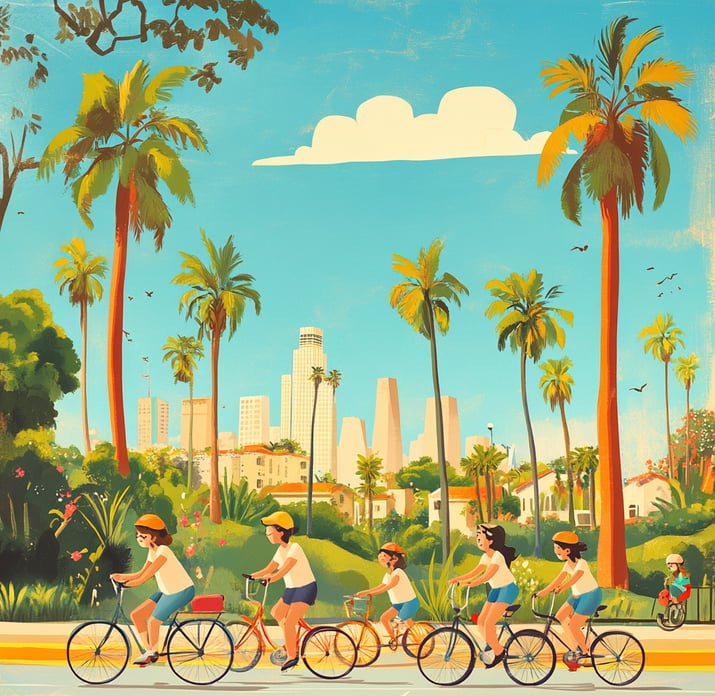The Origins of CicLAvia: Transforming Los Angeles One Ride at a Time
CicLAvia has changed the way Angelenos experience their city, transforming crowded streets into vibrant, car-free zones that promote cycling, walking, and community engagement. Inspired by Bogotá, Colombia’s Ciclovía, which began in 1974, CicLAvia has grown into one of the most successful open-street initiatives in the United States. Since it started, it has encouraged sustainable transportation, enhanced civic pride, and cultivated a new urban culture centered on mobility and public spaces (CicLAvia, 2015).
COMMUNITYSTATE & LOCAL GOVERNMENT
Dr. Shawn Granger
3/4/20253 min read


The Inspiration: Ciclovía in Bogotá
The foundation of CicLAvia can be traced back to Bogotá’s Ciclovía. This initiative closes streets to vehicular traffic every Sunday and on holidays, allowing people to engage in physical activities such as cycling, jogging, and skating. Gil Peñalosa, former Commissioner of Parks and Recreation in Bogotá, emphasized the purpose of the initiative by stating, "The goal was to reclaim the streets for the people and promote an active, healthy lifestyle" (Peñalosa, 2009). This concept inspired urban planners and activists worldwide, including those in Los Angeles, envisioning a similar event for their city.
The Founding of CicLAvia
CicLAvia was officially established in 2008 by a coalition of activists, urban planners, and community leaders committed to addressing Los Angeles' reliance on automobiles and the lack of public spaces for pedestrians and cyclists. The initiative gained traction through the efforts of Aaron Paley, a cultural event organizer who was instrumental in securing funding and city support. "We saw this as an opportunity to reimagine Los Angeles, to show people what the city could look like without cars," Paley explained (CicLAvia, 2015).
The coalition worked closely with city officials, including then-Mayor Antonio Villaraigosa, who became a strong advocate for the initiative. Villaraigosa emphasized its broader impact, stating, "CicLAvia is more than just a bike ride; it’s a movement that brings communities together and encourages people to see their neighborhoods from a new perspective" (Villaraigosa, 2010). After extensive planning, fundraising, and public outreach, the first CicLAvia event occurred on October 10, 2010.
Timeline of CicLAvia’s Growth
2008: A group of community leaders, inspired by Bogotá’s Ciclovía, begin organizing an open-streets event for Los Angeles.
2010: The first CicLAvia event occurs on October 10, covering 7.5 miles from East Hollywood to Boyle Heights.
2013: Expansion of routes, including new locations such as Venice Beach and South Los Angeles.
2015: The event draws over 100,000 participants, solidifying its status as a major civic event.
2018: CicLAvia hosts its 25th event, expanding routes to the San Fernando Valley.
2022: More than 1.8 million people have participated in CicLAvia since its inception, making it one of the most significant open-streets initiatives in the U.S. (CicLAvia, 2023).
Impact on Los Angeles
CicLAvia has significantly changed perceptions of transportation in Los Angeles, a city historically defined by car dependency. The event promotes alternative modes of travel and emphasizes the need for improved cycling and pedestrian infrastructure. A 2019 UCLA study highlighted this impact: "CicLAvia has contributed to a shift in public attitudes towards sustainable transportation, leading to increased bike lane development and pedestrian-friendly policies" (UCLA Institute of Transportation Studies, 2019).
Local businesses have also thrived, with many reporting increased foot traffic and higher sales. "CicLAvia days are some of our busiest days of the year," remarked Maria Lopez, the owner of a café along one of the routes (Lopez, 2021). Furthermore, the event has strengthened social bonds among diverse communities. "Seeing so many different people come together for a shared experience makes CicLAvia so special," expressed CicLAvia Executive Director Romel Pascual (Pascual, 2022).
The Future of CicLAvia
As Los Angeles evolves, CicLAvia remains a cornerstone of the city’s efforts toward a more sustainable, people-centered urban environment. City officials and organizers are exploring ways to make car-free streets a permanent fixture in certain neighborhoods. "We envision a future where open streets are a regular part of urban life, not just a special event," said Pascual (CicLAvia, 2023).
With increasing backing from policymakers, urban planners, and residents, CicLAvia is set to broaden its influence, inspiring similar initiatives across the country. Peñalosa once stated, "The success of these events proves that cities are for people, not just for cars" (Peñalosa, 2009).
References
CicLAvia. (2015). Reimagining Los Angeles: The impact of open streets events. Retrieved from https://www.ciclavia.org
CicLAvia. (2023). A vision for the future of open streets in Los Angeles. Retrieved from https://www.ciclavia.org
Lopez, M. (2021). Personal interview on the economic impact of CicLAvia.
Pascual, R. (2022). CicLAvia and the power of open streets. CicLAvia Press.
Peñalosa, G. (2009). Cities for people, not for cars. Urban Development Press.
UCLA Institute of Transportation Studies. (2019). The effects of CicLAvia on sustainable transportation in Los Angeles. UCLA Urban Policy Journal.
Villaraigosa, A. (2010). Los Angeles embraces CicLAvia. City of Los Angeles Press Conference.
